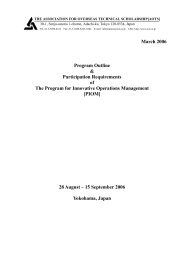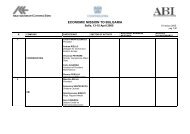Analysis of the Operation and Financial Condition of the Enterprise
Analysis of the Operation and Financial Condition of the Enterprise
Analysis of the Operation and Financial Condition of the Enterprise
You also want an ePaper? Increase the reach of your titles
YUMPU automatically turns print PDFs into web optimized ePapers that Google loves.
<strong>Analysis</strong> <strong>of</strong> <strong>the</strong> <strong>Operation</strong> <strong>and</strong> <strong>Financial</strong> <strong>Condition</strong> <strong>of</strong> <strong>the</strong> <strong>Enterprise</strong>This section covers: Description <strong>of</strong> financial ratios - considers <strong>the</strong> measures used in calculating ratios(e.g. assets, turnover, equity) <strong>and</strong> proposes comparisons with:o industry average figures;o same ratios for <strong>the</strong> previous years;o figures <strong>of</strong> competitor enterprises; Liquidity measures - two viewpoints on liquidity – viewing enterprise as about tobe liquidated or as going concern; Describes disadvantages <strong>of</strong> liquidity measures; Quick ratio; Absolute liquidity ratio.o Solvency measures - this part consider measures such as ownership ratio, debt ratio,interest cover, etc.;o Activity measures - multiple measures are considered in this part e.g. current assetturnover, stock turnover. The distinction between operating cycle <strong>and</strong> cash cycle isdiscussed;o Pr<strong>of</strong>itability measures - various definitions <strong>of</strong> pr<strong>of</strong>itability.o Trading pr<strong>of</strong>itability (return from sales), pr<strong>of</strong>itability <strong>of</strong> investing (return oninvestment) <strong>and</strong> financial pr<strong>of</strong>itability (return on capital employed) are considered.4. <strong>Financial</strong> Performance RatiosPrimary ratio - Return on net assetsSecondary ratios:o Pr<strong>of</strong>it margin;o Asset turnover;Third level ratios -o Measures for control over revenues <strong>and</strong> costso gross pr<strong>of</strong>it / amount <strong>of</strong> sales;o variable costs / amount <strong>of</strong> sales ...o Use <strong>of</strong> assets: fixed assets / amount <strong>of</strong> sales.<strong>Financial</strong> performance measureso Liquidity Current ratio;o Quick ratio;o Stock, debtors’,o Creditors’ turnovero Collection periods, etc.o Solvency, Interest cover.Investment ratioso Return on shareholders’ equity pr<strong>of</strong>it after tax <strong>and</strong> interest / total equity;o Earnings per share pr<strong>of</strong>it after interest <strong>and</strong> tax / number <strong>of</strong> shares;o Price / earnings ratio;o Investment ratios are more common in practice for larger;o companies, where users <strong>of</strong> financial analysis could be large investment institutionse.g. pension funds.7
















